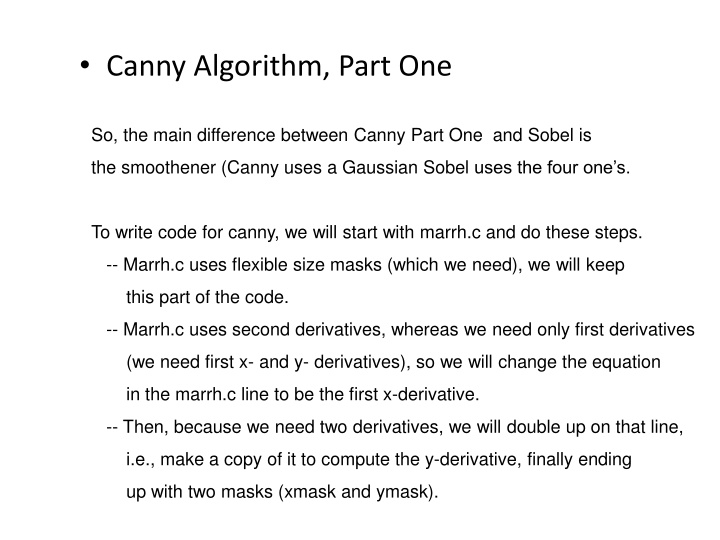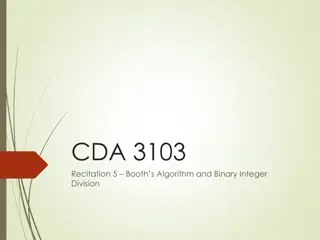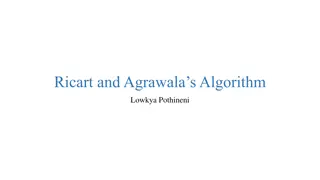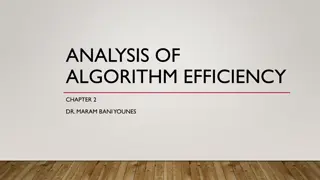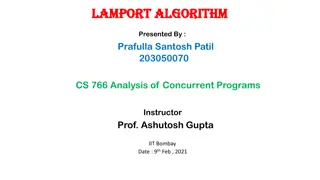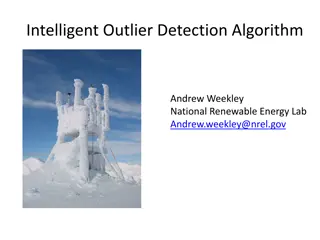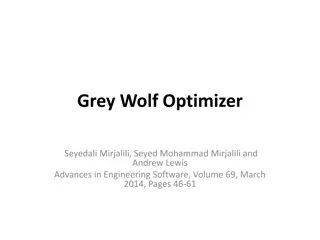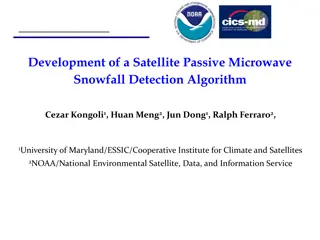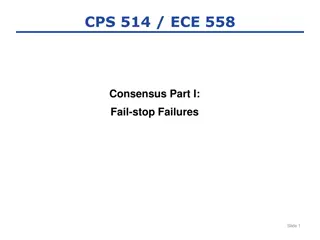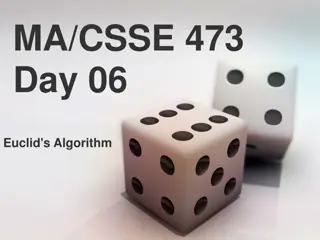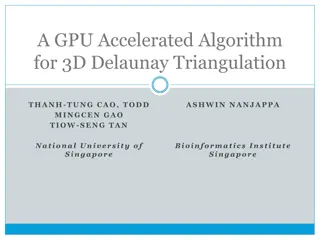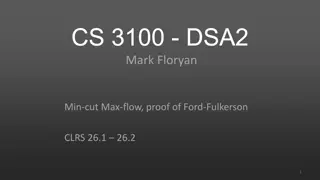• Canny Algorithm, Part One
The Canny algorithm Part One introduces the main differences between Canny and Sobel edges detection methods, focusing on the use of Gaussian smoothing and first derivatives. The step-by-step approach involves adjusting Marrh code, utilizing convolution, scaling the magnitude image, and producing outputs comparable to Sobel results. Part Two delves into non-maxima suppression and visualizing ridges in the magnitude image as relief maps to identify edges effectively.
Uploaded on Feb 24, 2025 | 0 Views
Download Presentation

Please find below an Image/Link to download the presentation.
The content on the website is provided AS IS for your information and personal use only. It may not be sold, licensed, or shared on other websites without obtaining consent from the author.If you encounter any issues during the download, it is possible that the publisher has removed the file from their server.
You are allowed to download the files provided on this website for personal or commercial use, subject to the condition that they are used lawfully. All files are the property of their respective owners.
The content on the website is provided AS IS for your information and personal use only. It may not be sold, licensed, or shared on other websites without obtaining consent from the author.
E N D
Presentation Transcript
Canny Algorithm, Part One So, the main difference between Canny Part One and Sobel is the smoothener (Canny uses a Gaussian Sobel uses the four one s. To write code for canny, we will start with marrh.c and do these steps. -- Marrh.c uses flexible size masks (which we need), we will keep this part of the code. -- Marrh.c uses second derivatives, whereas we need only first derivatives (we need first x- and y- derivatives), so we will change the equation in the marrh.c line to be the first x-derivative. -- Then, because we need two derivatives, we will double up on that line, i.e., make a copy of it to compute the y-derivative, finally ending up with two masks (xmask and ymask).
Canny Algorithm, Part One -- Then use the convolution code from marrh but remember to double up on it, to get two outputs. -- Then delete the code in marrh that is below the convolution code. -- Then bring in the sqrt (of squares) code from sobel. This will compute the magnitude, will scale it for output, and will print it out. -- At this point, you are done with Canny part One, and your code should produce output very similar to the Sobel magnitude image.
Canny Part Two Normally called Non-maximaSuppression We will call it RidgePeaks of Magnitude Image
Canny Part Two Consider the Magnitude image obtained in Part One Think about it as a terrain map. So, its numbers represent height.
Canny Part Two The Magnitude image can be viewed as a relief map (on right) Let us examine a ridge in this relief map (the magnitude pic)
Canny Part Two Visualize ridges in this relief map (the magnitude image). Two different ways to visualize are shown here. Figure is from internet Figure is from internet Ridges in the magnitude image represent edges. The stronger the brightness jump in the original picture, the higher the ridge in the magnitude image.
Canny Part Two Consider some ridges, and how to find their peaks. For the ridges shown, we would want to traverse a row, such as, say, B, C, D, or E, and ask if we are finding a peak as we encounter the values in that row. A Peak is simply a position whose magnitude value exceeds that of the neighbor to the left and to the right. This is MaxTest. Figure is from internet
Canny Part Two Direction for MaxTest: MaxTest runs across these rows. If we knew that the ridge is a vertical one (as these examples are), we would NOT want to run MaxTest in a vertical direction or in a diagonal direction (for these specific ridges). i.e., MaxTest runs in a direction perpendicular to the ridge. Figure is from internet
Canny Part Two MaxTest sDirection: Hmmm Perpendicular to the ridge?? MaxTest runs in a direction perpendicular to the ridge. Well, that is simply IN THE DIRECTION OF THE GRADIENT! Figure is from internet The gradient was a vector. We used its Magnitude. Now we get to employ its Direction.
Actual code for Peaks for(i=MR;i<256-MR;i++){ for(j=MR;j<256-MR;j++){ if((xconv[i][j]) == 0.0) { xconv[i][j] = .00001; } slope = yconv[i][j]/xconv[i][j]; if( (slope <= .4142)&&(slope > -.4142)){ if((mag[i][j] > mag[i][j-1])&&(mag[i][j] > mag[i][j+1])){ cand[i][j] = 255; } } else if( (slope <= 2.4142)&&(slope > .4142)){ if((mag[i][j] > mag[i-1][j-1])&&(mag[i][j] > mag[i+1][j+1])){ cand[i][j] = 255; } } else if( (slope <= -.4142)&&(slope > -2.4142)){ if((mag[i][j] > mag[i+1][j-1])&&(mag[i][j] > mag[i-1][j+1])){ cand[i][j] = 255; } }else{ if((mag[i][j] > mag[i-1][j])&&(mag[i][j] > mag[i+1][j])){ cand[i][j] = 255; } } } }
